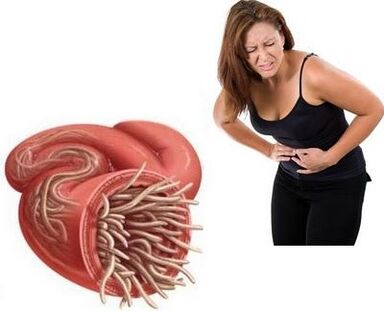Parasite - This is the name of one of the most common infectious disease groups.Today, about 300 parasites are known, which are dangerous to humans, including deadly parasites.On the territory of the continent, these only have dozens of parasites (medical name - Helmincias, helmsman invasion).
The largest segment of human-related parasites are common in countries with low tropical and subtropical climates as well as socio-economic development and health culture.
What are dangerous parasites

Parasites in the human body affect almost any organ system.The degree of damage depends on the type of worm, the duration of the disease, and the initial health status.The earlier a diagnosis of a specific worm invasion is established, the more chances of getting rid of the parasites quickly.This is why it is important to diagnose parasite invasion conditions in a timely manner and perform all treatment phases.
Almost all worm lesions, especially for a long time, can cause significant harm to the human body.The reasons for delaying psychological motor development in children of any age greatly reduce the performance and lifespan of adults.
Regardless of a person's age, worm invasion can contribute to allergies, reducing the immune system's ability to fight infections and other diseases, and in addition, the effectiveness of continuous prevention vaccines is greatly reduced.
In rare cases, cleaning the parasite's body occurs spontaneously, and in most cases it is necessary to follow a certain scheme.
What is a parasite

Parasites (they are also worms or worms) are organisms with a wide range of multicellular complex arrangements that can exist for a long time under a variety of conditions.An important feature is the ability to exist in another creature (human or animal), called "invasion".
Currently, various types of parasites are known in the human body.The most common classification of parasites depends on their external structure and characteristics of their life cycle.
Given biological characteristics, all parasites are divided into 3 major categories:
- round worms (they are also nematodes), for example, caterpillars, aneurysms, pins, ascalis;
- Ribbon worms (they are also Cestodes), such as alveoli, spinoscopic, tape width, cattle tap, pork, pork and dwarf;
- Super (they are also Tremontodes), such as Opistorch, fasciol, Clonorch.
Furthermore, like many other diseases, parasite diseases are different:
- Severity;
- by leadership syndrome, i.e. which organ system is damaged to a greater extent;
- According to the presence and nature of the complications;
- Depending on possible outcomes of the disease.
Characteristics of parasites
Development stage
Parasitic diseases are characterized by their characteristics and their life cycle.
As long as there is no new infection, the number of adults with parasites in the human body will not increase.To implement the life cycle, most parasites need to change habitat (animals, soil, etc.).
For any parasite, the development stage is typical.Throughout his life cycle, Helminth has passed many changing stages of development.Typically, the parasite egg is transformed into a larvae, which is then further transformed into an adult.Reverse development does not occur, and eggs cannot enter the adult stage immediately.
The parasite penetrates the human body at one stage of its life cycle and then enters the body of another.It is at this moment that the actual human non-treatment of human parasitic diseases is relevant.That is, most parasitic disease infections that are not likely to be directly in contact with the infected person.
Possible paths that may penetrate into the human body
With multiple types of parasites, one can meet anywhere - they are not visible to the naked eye.The following options are most likely:
- oral pathways, i.e. non-compliant with personal hygiene, use of dirty or unprocessed products;
- The percutaneous pathway, in which adults of larvae or parasite penetrate the body through damage to the skin (when in contact with water or soil).
Most parasites that affect the human body are only in adulthood, mainly in the digestive tract.These are what So calls the gut parasites (Helminths).In turn, they are divided into two groups according to certain functions.
The first group of intestinal parasites enter the human body in the form of eggs.In the digestive tract, they are transformed into adults.The movement of this parasite (Pinworms, broadband, pork and cattle tapeworms) is limited only by different departments of the digestive tract.
Depending on the various tissues and organs of the human body, the representation of the second group (its larvae or egg) (its larvae or egg) has longer and complex performance.Only after that are adults who form parasites.Obviously, the symptoms of this parasitic disease are more diverse because the migration process is related to major changes in the body.
In the adult or larval stage, the parasite is located outside the digestive tract and is called tissue.If in the human body, the parasite only exists in the larvae stage, then he is an ecological dead end for him and Helmt cannot leave.
Characteristics of parasite life cycle
To know how to get rid of parasites in the body, it is necessary to represent their life cycle in general.This knowledge also helps prevent parasites from entering the body.
According to the characteristics of the life cycle, all parasites are divided into:
- Geographical parasites;
- contagious helmsman;
- Biological respiratory disease.
In order to implement the life cycle of geoparasites (Vrasov, a non-core), it is necessary to occupy a certain amount of time in the soil.In the future, inadequate washing vegetables will be used as direct contact with dirty soil and parasites penetrate into the human body through dirty hands.
In contagiosteal parasites (Pinworms, dwarf Tabells), all developmental stages occur only in the human body without environmental changes.Only these types of parasitic diseases are directly transmitted from person to person.Especially in childhood, it is a case that is automatically passed down from generation to generation, that is, in case of disobeying hygiene rules and skills, from oneself.
SO is called the most complex life cycle in Biogelmintosis.A prerequisite for implementing its life cycle is the existence of an intermediate host.A person can be an intermediate or final master.For example, for echinococciosis, a person is the intermediate host, while dogs and cats are ultimate.On the contrary, in terms of Tusherinchosis, the cattle represents the intermediate host, and one is the final one.
Symptoms of parasites
On the one hand, the clinical signs of parasites depend on the main damage to a particular organ, and on the other hand, they have general characteristics that allow us to distinguish between the acute and chronic stages of parasitic diseases.
The acute phase of parasitic disease corresponds to the migration phase of developing germ.It is manifested by clinical signs (such as allergies and common toxic reactions) (casworm disease, schistosomiasis, fascia, capillary disease).
Immunological components have significant weight in the development of the acute phase of parasitic disease, forming some stereotype of the clinical situation, and are similar to other immune responses that are non-infectious natural - drugs, allergic dermatitis, etc.
The hidden period of most parasitic diseases is weeks and is reduced to 7-10 days in the form of a large number of infections, and is less intense.
The main symptoms of parasitic diseases are as follows:
- Body temperature rises - from sub-release to very high;
- Pain in muscles and joints, various durations and intensity;
- The rash forms on the entire surface of the skin, with different sizes and strengths, accompanied by itchy skin.
- Significant edema in the skin and subcutaneous tissue, less - mucosa; the most typical yarn disease, makes the disease characterized by the popular name "Puffy".
- The development of pulmonary syndrome, that is, the night-scene cough, rapid, pneumonia, and the focal migration of damage;
- The development of abdominal syndrome, characterized by moderate abdominal pain, liquid feces are free of mucus and blood impurities.
- In severe cases, damage to the central nervous system and heart were observed.
- A unique feature of helminthosis is changes in peripheral blood: significant leukocytosis and significant eosinophilia (up to 30-40%).
The most effective treatment of the acute stage of human parasites.
During the chronic stage of parasitic disease, destructive effects are determined by the type of adult parasite.The adverse effects on the human body are related:
- greater toxicity and allergic reactions;
- Mechanically impairing tissues in parasitic areas (e.g., hepatic echinococci disease);
- Nutrition absorption, invasion of metabolic processes, development of anemia and cachexia;
- Severe anemia;
- A person's irritability and excitement increase;
- Secondary infections and malnutrition, other infectious and non-infectious diseases can be added to weight and pregnancy.
The duration of a single parasite exists differently - with days and weeks (cutters) to years.After a parasitic disease, it may re-infect because of no immunity.Therefore, cleaning the body from the parasite does not prevent repeated attacks.
Parasite treatment

Current classical drug therapy for parasite diseases has achieved great success.The introduction of clinical practice of benmidazole and imidazole compounds makes it possible to successfully treat multiple types of Helminthias.
These drugs have extensive exposure, small drugs and short-term treatment processes, suitable for both adults and children.The corresponding age of drug dosage should be observed.
How to clean the body of a specific parasite, which treatment options and what medication your doctor decides.It is not recommended to prevent worm disease because of the development of addiction to drugs, i.e., its impact is reduced.
Clean parasites
With the treatment of parasitic diseases, folk therapy treatment is far less than traditional medical methods.Proponents of parasitic diseases of natural tools focus on the safety and universality of this therapy.There are many traditional medical prescriptions that allow you to effectively deal with parasites in the human body.The following options for eliminating human parasites are the most famous:
- Coriander and pumpkin seeds serve as preventive and therapeutic agents for parasites;
- Alcohol tin on Chanterelles combines with white mushrooms;
- pine nut soup;
- Green walnut tin agent.
Any folk remedy for parasites should be followed by recipes and clean hands.Before choosing a specific recipe, it is important to make sure a person is not allergic to the ingredients of a portion of the medication.
How to protect yourself from parasites

It is both easy and difficult at the same time.Several simple rules will help minimize the risk of any parasite infection:
- Wash your hands thoroughly;
- The correct habit of using separate dishes;
- Thoroughly handle any meat and fish and use dry and salty fish and meat with caution;
- Treat vegetables and fruits with boiling water (after washing in running water);
- Be sure to wash your hands with soap after communicating with animals.
Parasite infections of any age are an unpleasant problem, but eliminate early treatment altogether.






































